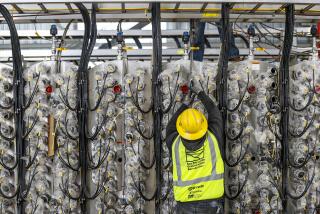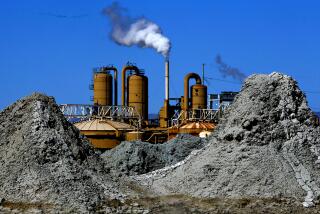Cleaning Up a Bad Mess : Lockheed and Burbank Grapple With Costly Cleanup at Skunk Works
BURBANK — It’s been 15 years since the first taint of sweet-smelling solvent was detected in drinking-water wells around Burbank. Today, cleanup of toxic waste here is one of the nation’s larger Superfund projects, and for Lockheed Corp., which is now paying much of the cleanup bill, the headaches keep getting bigger.
Much of the ground-water contamination consists of just one chemical--a solvent called perchloroethylene--which filtered down through the dirt under the Calabasas-based firm’s legendary Skunk Works research site in Burbank. The Skunk Works site, now vacated, was the birthplace of many a Lockheed triumph, from U-2 spy planes to the arrowhead-shaped Stealth fighter.
Both Lockheed and Burbank city officials have discovered that the duration and cost of this cleanup is a far cry from what they anticipated only a few years ago.
Lockheed now says that the cost of cleaning the water and soil may hit $300 million over the next decade--probably twice the current value of Lockheed’s land in Burbank, according to city officials. As the years pass, Burbank officials watching the cleanup have grown increasingly glum. The city expected a tax windfall from a speedy sale of Lockheed’s property and the construction of a shopping mall and offices there, but those hopes have been dampened.
As recently as 1990, Lockheed told shareholders that the sale of its vacated properties in Burbank would pay for moving the Skunk Works operation and even result in a profit. Instead, Lockheed still owns nearly 300 acres of unused land around Burbank Airport, the value of which has plummeted.
To date, the company says it has spent well over $100 million on soil and ground-water cleanup. And in 1993, Lockheed charged off $35 million against its Burbank holdings in part because of sinking real estate values. “Lockheed has been disappointed by how expensive (the cleanup) is. They used to have dreams of selling the property. Now it’s more damage limitation than anything else,” said Wolfgang Demisch, aerospace analyst with BT Securities Corp.
Lockheed is the largest landowner of dozens of Burbank-area firms targeted by the U.S. Environmental Protection Agency in the cleanup of the ground-water lake that lies 150 feet under the San Fernando Valley floor, and Lockheed has assumed most of the burden of the cleanup in Burbank under the federal Superfund law. (However, the company has filed a lawsuit alleging pollution by certain neighboring firms in an attempt to recoup some of its costs.)
*
Lockheed’s current cleanup effort consists of two parts. The first is to clean the ground water. For that, the company recently built a water-treatment plant off Hollywood Way. This summer it is expected to start sucking up water, stripping it of perchloroethylene and other toxins, and putting it back in the ground. Lockheed had agreed to operate the plant until the year 2000, but restoring the purity of the ground water here may require decades of treatment, the EPA said.
The second part of the cleanup deals with tainted soil. The target area is a 103-acre swatch along Empire Avenue where solvents have penetrated deep into the ground, said David Seter, regional project manager with the EPA. Lockheed has toppled millions of square feet of buildings here, which in itself required a large-scale asbestos cleanup, and the site is now just a dirt field surrounded by a high, green fence.
Lockheed has proposed building a plant on the Empire Avenue property that would vacuum gases from the soil through underground pipes, sucking them through huge canisters of toxin-cleansing carbon. This proposal has met with heated opposition from Burbank residents, because a small amount of perchloroethylene would be released into the air. The opposition has delayed approval by local air-quality officials and sent Lockheed back to the drawing board to come up with a proposal that would produce fewer emissions.
The company is currently negotiating with Homart Development Co. of Chicago, which may buy the Empire Avenue property on which the soil-treatment gas plant has been proposed. Burbank officials say Homart wants to build industrial space, offices and large discount stores there. But Homart is just the latest of several developers who have stepped forward in hopes of building a “power center” on the site--basically a shopping mall of big retailers such as K mart and Price Club. Nothing has come of these proposals so far. There was even brief talk of building a sports arena on the spot.
Now, Lockheed corporate real estate director Ken Philbrick said that with careful planning, Homart could start building on the property while it is still being cleaned, perhaps within the next three years. But Joseph Kornwasser, a Los Angeles developer who once tried to build a shopping mall there, said: “I doubt that (time frame) is realistic.” The site has good potential, but financial and legal issues linked to the cleanup may stall its development, he added.
This slow process has been a big disappointment for Burbank officials. At first, Burbank officials calculated that the sale and redevelopment of Lockheed’s land into office parks and shopping malls would instantly quadruple the city’s property-tax base, said City Manager Bud Ovrom.
Lockheed has been paying low taxes on its Burbank properties because it acquired many of them in the 1930s and was shielded from large tax hikes by Proposition 13. A recent Lockheed brochure put the company’s yearly tax bill for Burbank holdings at just $3.2 million.
Now, Ovrom estimates that the value of Lockheed’s Burbank land has plunged to about $500,000 per acre from the $1 million they were worth in the late 1980s. Many of the big discount stores the city hoped to lure have since built elsewhere. Moreover, with the recession and corporate layoffs, the Valley now has ample industrial property awaiting development. “This isn’t a unique opportunity anymore,” Ovrom said.
“We anticipated it would probably take three years” to convert Lockheed’s property and attract new tenants, Ovrom said. “Well, it’s been five years already and there is no light at the end of the tunnel.”
For all its problems, Lockheed has made some progress. It settled with the EPA to assume some cleanup costs sooner than many other companies, said Marie Rongone, the EPA’s assistant regional counsel. Rongone also said that Lockheed hasn’t scrimped on the ground-water cleanup, and called its water-treatment facility a “Cadillac job.” And at least 80 acres of former Skunk Works property have already been sold or leased to other interests.
However, after Lockheed demolished buildings on the Empire Avenue site, the company’s investigators discovered that it is more polluted than anyone originally suspected. Hundreds of holes dug on the cleared site revealed that solvents--perchloroethylene and trichloroethylene--had penetrated the soil at least 130 feet and were trickling into the ground water below, said Alex Carlos, associate engineering geologist with the Los Angeles Regional Water Quality Control Board. The cleanup “has been a learning experience for us. We didn’t know the extent of the problem. Now we do,” said Steve Chaudet, vice president of public affairs for Lockheed.
Early estimates by the EPA put the cost of the Superfund cleanup, chiefly for ground water, at about $69 million. Now, Lockheed said it will cost $175 million to clean the ground water around Burbank and another $115 million for the clearing of buildings and future soil treatment on the Empire Avenue site. A Lockheed official said that the company may have to spend an additional $60 million on soil cleanup around Burbank.
The goal of these efforts is the restoration of the vast drinking water reservoir deep beneath the Valley floor.
Today, only about 30 of the 90 drinking water wells that tap the Valley’s underground lake are free of toxic chemicals. Much of the water we drink is brought in from elsewhere, and some of the water under the Valley must be treated before it can be used.
For a long time Lockheed dipped machine parts into tanks of perchloroethylene and other toxins to clean them in Burbank. Lockheed now estimates that 75,000 gallons of the solvent got into the ground under the manufacturing plants that once stood on Empire Avenue. The company has no specific explanation for what went awry.
“Accidents happen,” said Philbrick, the real estate manager.
As for the long-term costs of the Skunk Works cleanup, it may take Lockheed years to fully tally it up.
Meanwhile, the company is pursuing a controversial plan to bill part of the cleanup to the Pentagon through charges in future defense contracts. Lockheed is also looking to insurance to help defray the cleanup costs, and other polluters may be forced to pay a share.
In the meantime, with the entrepreneurial verve that analysts say characterizes the Skunk Works culture, Lockheed has drawn attention as a strong competitor in the emerging market for environmental services and equipment.
The company’s Environmental Systems and Technologies unit in Houston, which is managing the Burbank cleanup, has won big government contracts in recent months.
The unit played a key role in helping Lockheed land a $5-billion management contract at the Department of Energy’s 890-acre Idaho National Engineering Laboratory. This nuclear research lab is being converted into an environmental-technology research center for the private sector but first has to clean up the toxic waste generated by its past defense work.
Lockheed also won a $179-million contract to clean nuclear waste stashed in cardboard boxes at the same Idaho site.
These contracts probably have little direct relation to the situation at the Skunk Works, which is not a nuclear site. But they hint at a promising future for Lockheed in the cleanup business.
Nowadays, the company is building an image as a competitive force in the environmental industry. A recent Lockheed brochure proclaims: “All of us are environmentalists. All of us are concerned about the earth.”
More to Read
Inside the business of entertainment
The Wide Shot brings you news, analysis and insights on everything from streaming wars to production — and what it all means for the future.
You may occasionally receive promotional content from the Los Angeles Times.










